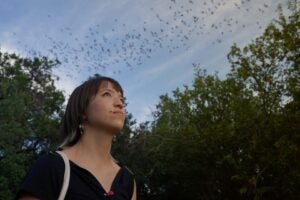Original run date:
Sept. 28, 2007
In the 1920s, J.T. Patterson, the chairman of the Department of Zoology, wanted to push his school into the top ranks of genetic research. So he did what Texans do, he recruited a top player for his team.
The recruit was Hermann J. Muller, a born-and-raised New Yorker who had spent most of his academic career as a student and researcher at Columbia University. He was establishing a reputation as an innovative thinker in genetics.
Muller made good on Patterson’s decision by making one of the most significant discoveries at The University of Texas at Austin.
He demonstrated that radiation from X-rays would change the genetic makeup of fruit flies and that the mutations would be passed to subsequent generations. It was the first time that men had intentionally altered the genetics of another creature.
It changed understanding of the gene, revolutionized genetics research, made headlines around the world and put Texas on the science map.
In 1946, the research won the Nobel Prize for physiology or medicine. But by then Muller was long gone from Texas and was settling in to what would be a 20-year stay at Indiana University in Bloomington, Ind.
The Discovery
Muller’s findings excited the science community when he published them in Science in July 1927. They also received much mainstream attention.

“Altered Heredity of Flies By X-Ray” was the headline in the New York Times.
The significance of Muller’s discovery might get lost in the early 21st century, when scientists manipulate genes at will.
Then, however, it opened scientists’ eyes to the vast possibilities of genetics.
“At that point, no one really knew how mutations were caused or what factors were involved in mutations,” said David Hillis, a professor of integrative biology at the university. “So the connection between radiation and mutation was a big step.”
“In a few months Muller found more mutant genes than the total from all the Drosophila labs up to that time,” said James F. Crow, professor emeritus at the University of Wisconsin-Madison, who was a graduate student at Texas in the 1930s and later became friends with Muller.
Besides the impact on the study of genetics, Muller realized the experiments showed that radiation posed threats beyond the laboratory. He made that point in his first paper on the experiments.
He spoke out about the dangers of radiation on people. The Nobel Prize in 1946 increased his stature to speak out about it after atomic bombs were dropped on Nagasaki and Hiroshima in 1945.
“He understood the dangers of radiation much sooner than most people did,” said Chandra Muller, his granddaughter and a professor of sociology at the university. “In our family, growing up, whenever we’d go to the dentist, my mother would get in a fight with the dentist. We couldn’t have the X-rays.”
“My grandfather was quite politically involved and used his position as a Nobel Laureate and an authority on the ionizing effects of radiation to speak out forcefully against nuclear arms,” said Ken Muller, a neuroscientist at the Miller School of Medicine at the University of Miami. “I’d like to think that much of our concern about nuclear proliferation is in some small way due to his efforts.”
Read the full story about Muller’s time at The University of Texas at Austin, his private life and how others remember his contributions to science.



